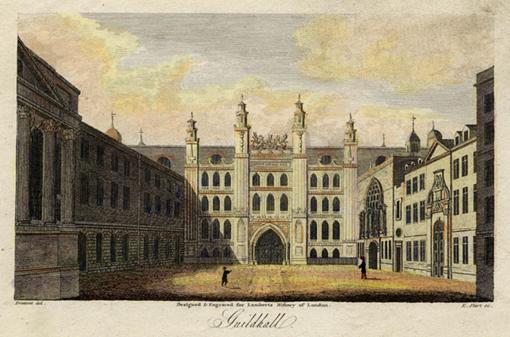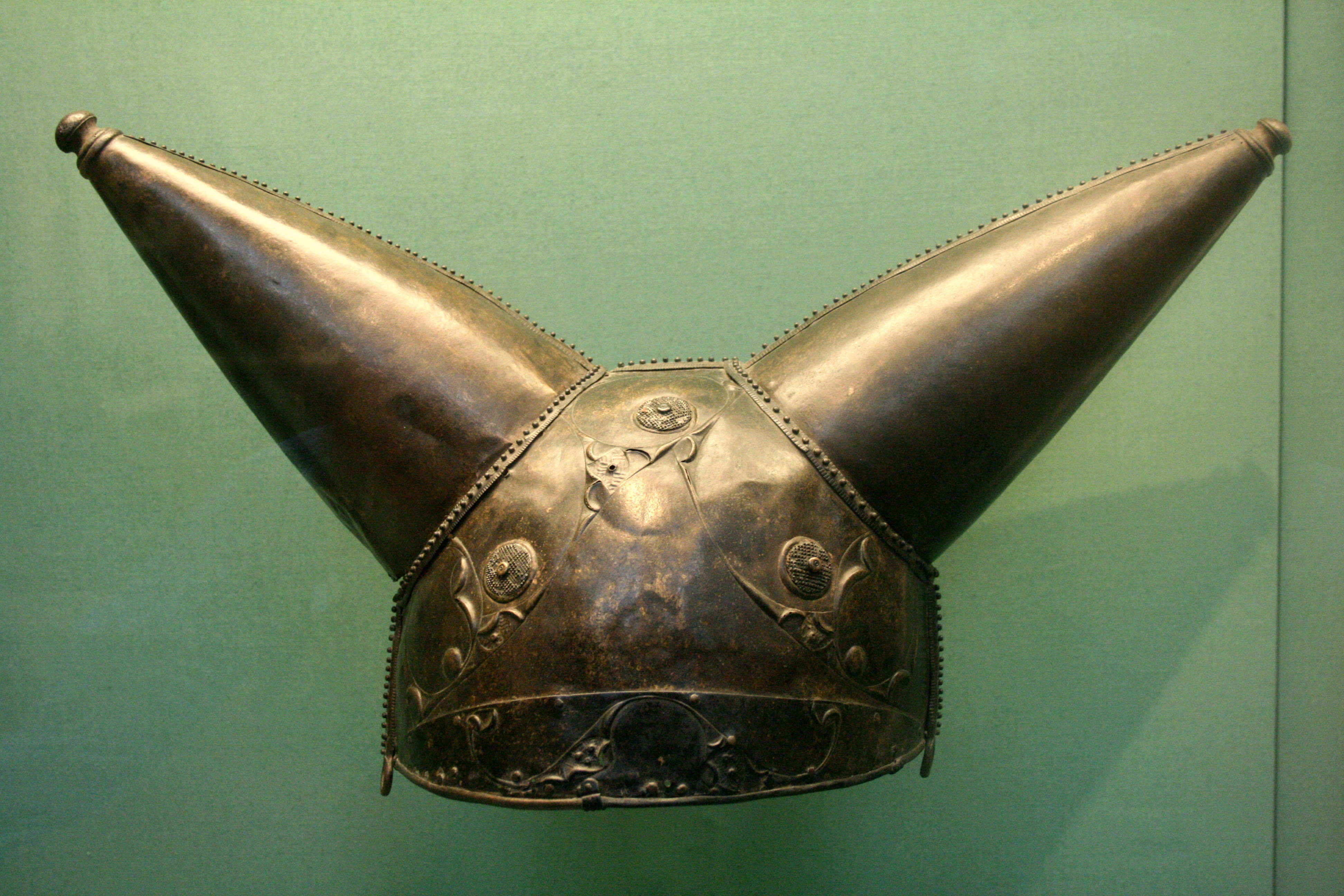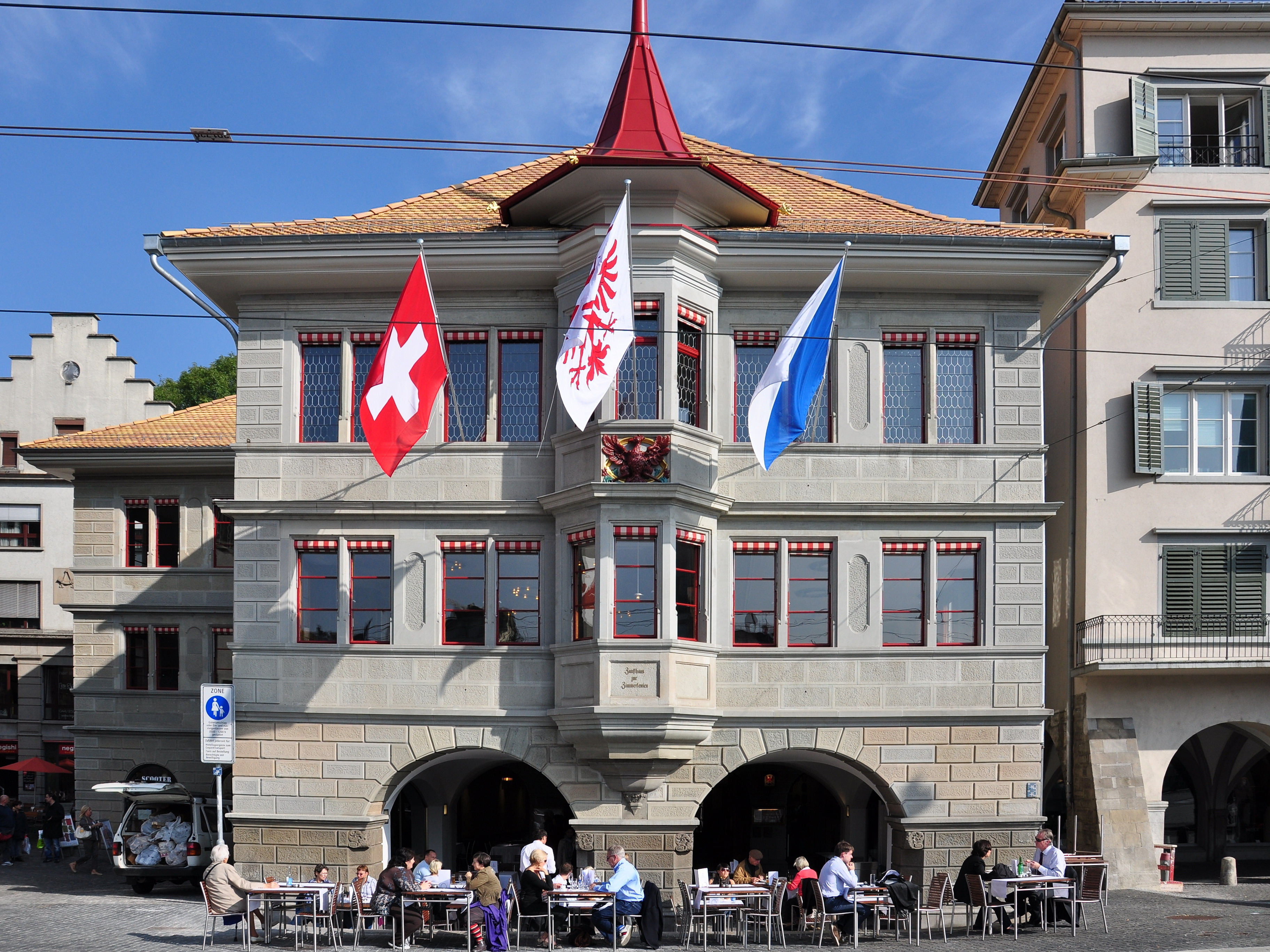|
Guildhall, London
Guildhall is a municipal building in the City of London, England. It is off Gresham and Basinghall streets, in the wards of Bassishaw and Cheap. The current building dates from the 15th century; however documentary evidence suggests that a guildhall had existed at the site since at least the early 12th century. The building has been used as a town hall for several hundred years, and is still the ceremonial and administrative centre of the City of London and its Corporation. It should not be confused with London's City Hall, the administrative centre for Greater London in Canning Town. The term "Guildhall" refers both to the whole building and to its main room, which is a medieval great hall. It is a Grade I-listed building. History Roman, Anglo-Saxon and Medieval During the Roman period, the Guildhall was the site of the London Roman Amphitheatre, rediscovered as recently as 1988. It was the largest in Roman Britain, partial remains of which are on public display in t ... [...More Info...] [...Related Items...] OR: [Wikipedia] [Google] [Baidu] |
City Of London
The City of London, also known as ''the City'', is a Ceremonial counties of England, ceremonial county and Districts of England, local government district with City status in the United Kingdom, city status in England. It is the Old town, historic centre of London, though it forms only a small part of the larger Greater London metropolis. The City of London had a population of 8,583 at the 2021 United Kingdom census, 2021 census, however over 500,000 people were employed in the area as of 2019. It has an area of , the source of the nickname ''the Square Mile''. The City is a unique local authority area governed by the City of London Corporation, which is led by the Lord Mayor of London, Lord Mayor of the City of London. Together with Canary Wharf and the West End of London, West End, the City of London forms the primary central business district of London, which is one of the leading financial centres of the world. The Bank of England and the London Stock Exchange are both ba ... [...More Info...] [...Related Items...] OR: [Wikipedia] [Google] [Baidu] |
Guildhall Art Gallery
The Guildhall Art Gallery houses the art collection of the City of London, England. The museum is located in the Moorgate area of the City of London. It is a stone building in a semi-Gothic style intended to be sympathetic to the historic Guildhall, London, Guildhall, which is adjacent and to which it is connected internally. History The City of London Corporation had commissioned and collected portraits since 1670, originally to hang in the Guildhall, London, Guildhall. In the 19th and 20th centuries, the Corporation's art collections grew through gifts and bequests to include history paintings and other genres of art. The first purpose-built gallery for displaying the collection was completed in . This building was destroyed in The Blitz in 1941, resulting in the loss of 164 paintings, drawings, watercolours, and prints, and 20 sculptures. It was not until 1985 that the City of London Corporation decided to redevelop the site and build a new gallery. The building was design ... [...More Info...] [...Related Items...] OR: [Wikipedia] [Google] [Baidu] |
Great Fire Of London
The Great Fire of London was a major conflagration that swept through central London from Sunday 2 September to Wednesday 5 September 1666, gutting the medieval City of London inside the old London Wall, Roman city wall, while also extending past the wall to the west. The death toll is generally thought to have been relatively small, although some historians have challenged this belief. The fire started in a bakery in Pudding Lane shortly after midnight on Sunday 2 September, and spread rapidly. The use of the major firefighting technique of the time, the creation of firebreaks by means of removing structures in the fire's path, was critically delayed due to the indecisiveness of the Lord Mayor of London, Lord Mayor, Sir Thomas Bloodworth. By the time large-scale demolitions were ordered on Sunday night, the wind had already fanned the bakery fire into a firestorm which defeated such measures. The fire pushed north on Monday into the heart of the City. Order in the streets ... [...More Info...] [...Related Items...] OR: [Wikipedia] [Google] [Baidu] |
Monument To Winston Churchill, Guildhall, London
A monument is a type of structure that was explicitly created to commemorate a person or event, or which has become relevant to a social group as a part of their remembrance of historic times or cultural heritage, due to its artistic, historical, political, technical or architectural importance. Examples of monuments include statues, (war) memorials, historical buildings, archaeological sites, and cultural assets. If there is a public interest in its preservation, a monument can for example be listed as a UNESCO World Heritage Site. The '' Palgrave Encyclopedia of Cultural Heritage and Conflict'' gives the next definition of monument:Monuments result from social practices of construction or conservation of material artifacts through which the ideology of their promoters is manifested. The concept of the modern monument emerged with the development of capital and the nation-state in the fifteenth century when the ruling classes began to build and conserve what were termed monument ... [...More Info...] [...Related Items...] OR: [Wikipedia] [Google] [Baidu] |
ONL (1887) 1
ONL may stand for: * Online In computer technology and telecommunications, online indicates a state of connectivity, and offline indicates a disconnected state. In modern terminology, this usually refers to an Internet connection, but (especially when expressed as "on lin ..., as used in text messaging and academic circles * Orange and Lemons, a Filipino band * Order of Newfoundland and Labrador, a title * Outer nuclear layer, a layer of the retina * Oosterhuis Lénárd architecture office by Kas Oosterhuis * Opening Night Live * O'Neill Municipal Airport {{disambig ... [...More Info...] [...Related Items...] OR: [Wikipedia] [Google] [Baidu] |
Guildhall Queen Victoria ILN 1863
A guildhall, also known as a guild hall or guild house, is a historical building originally used for tax collecting by municipalities or merchants in Europe, with many surviving today in Great Britain and the Low Countries. These buildings commonly become town halls and in some cases museums while retaining their original names. As town hall in the United Kingdom In the United Kingdom, a guildhall is usually a town hall: in the vast majority of cases, the guildhalls have never served as the meeting place of any specific guild. A suggested etymology is from the Anglo Saxon "''gild'', or "payment"; the guildhall being where citizens came to pay their rates. The London Guildhall was established around 1120. For the Scottish municipal equivalent see tolbooth. List of guildhalls in the United Kingdom *Andover Guildhall * Barnstaple Guildhall * Bath Guildhall *Beverley Guildhall *Bewdley Guildhall * Blakeney Guildhall * Bodmin Guildhall *Boston Guildhall *Bradninch Guildhall * Breco ... [...More Info...] [...Related Items...] OR: [Wikipedia] [Google] [Baidu] |
Trinovantum
Trinovantum is the name in medieval British legend that was given to London, according to Geoffrey of Monmouth's ''Historia Regum Britanniae'', when it was founded by the exiled Troy, Trojan Brutus of Troy, Brutus, who called it ''Troia Nova'' ("New Troy"), which was gradually corrupted to ''Trinovantum''. The legend says that it was later rebuilt by King Lud son of Heli, Lud, who named it ''Caer Lud'' ("Lud's Fort") after himself and that the name became corrupted to ''Kaer Llundain'' and finally London. The legend is part of the Matter of Britain. The name ''Trinovantum'' derives from the Iron Age tribe of the Trinovantes, who lived in Essex, Suffolk and part of Greater London and are mentioned by Julius Caesar in his account of his expeditions to Britain in 55 and 54 BC. In a later account of those expeditions by Paulus Orosius, Orosius, they are referred to as ''civitas Trinovantum'', "the nation of the Trinovantes", with ''Trinovantum'' in this case being in the genitive cas ... [...More Info...] [...Related Items...] OR: [Wikipedia] [Google] [Baidu] |
Historia Regum Britanniae
(''The History of the Kings of Britain''), originally called (''On the Deeds of the Britons''), is a fictitious account of British history, written around 1136 by Geoffrey of Monmouth. It chronicles the lives of the List of legendary kings of Britain, kings of the Britons over the course of two thousand years, beginning with the Troy, Trojans founding the Britons (historical), British nation and continuing until the Anglo-Saxons assumed control of much of Britain around the 7th century. It is one of the central pieces of the Matter of Britain. Although taken as historical truth until the 16th century, it is now considered to have no value as history. When events described, such as Julius Caesar's Caesar's invasions of Britain, invasions of Britain, can be corroborated from contemporary histories, Geoffrey's account can be seen to be wildly inaccurate. It remains, however, a valuable piece of medieval literature, which contains the earliest known version of the story of Leir o ... [...More Info...] [...Related Items...] OR: [Wikipedia] [Google] [Baidu] |
Geoffrey Of Monmouth
Geoffrey of Monmouth (; ; ) was a Catholic cleric from Monmouth, Wales, and one of the major figures in the development of British historiography and the popularity of tales of King Arthur. He is best known for his chronicle '' The History of the Kings of Britain'' ( or ') which was widely popular in its day, being translated into other languages from its original Latin. It was given historical credence well into the 16th century, but is now considered historically unreliable. Life and career Geoffrey was born between about 1090 and 1100, in Wales or the Welsh Marches. He had reached the age of majority by 1129 when he is recorded as witnessing a charter. Geoffrey refers to himself in his as (Geoffrey of Monmouth), which indicates a significant connection to Monmouth, Wales, and may refer to his birthplace. His works attest to some acquaintance with the place-names of the region. Geoffrey was known to his contemporaries as or variants thereof. The "Arthur" in these vers ... [...More Info...] [...Related Items...] OR: [Wikipedia] [Google] [Baidu] |
Brutus Of Troy
Brutus, also called Brute of Troy, is a mythical British king. He is described as a legendary descendant of the Trojan hero Aeneas, known in medieval British legend as the eponymous founder and first king of Britain. This legend first appears in the ''Historia Brittonum'', an anonymous 9th-century historical compilation to which commentary was added by Nennius, but is best known from the account given by the 12th-century chronicler Geoffrey of Monmouth in his . ''Historia Brittonum'' Some have suggested that attributing the origin of 'Britain' to the Latin 'Brutus' may be ultimately derived from Isidore of Seville's popular 7th-century work ''Etymologiae'' (c. 560–636), in which it was speculated that the name of Britain comes from ''bruti'', on the basis that the Britons were, in the eyes of that author, brutes, or savages. A more detailed story, set before the foundation of Rome, follows, in which Brutus is the grandson or great grandson of Aeneas – a legend that was perh ... [...More Info...] [...Related Items...] OR: [Wikipedia] [Google] [Baidu] |




